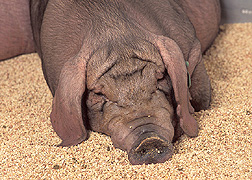This page has been archived and is being provided for reference purposes only. The page is no longer being updated, and therefore, links on the page may be invalid.
|
Read the magazine story to find out more. |
Chinese Pigs Help U.S. ResearchersBy David ElsteinNovember 12, 2002 To try to increase the number of offspring U.S. pigs produce, Agricultural Research Service scientists have been studying Chinese pigs since the late 1980s. In the process, researchers at the Roman L. Hruska U.S. Meat Animal Research Center (MARC) have found many interesting reproductive facts about the Meishan (pronounced MAY-shawn) pigs of southern China. The first was that the Meishan males had five to seven times more follicle stimulating hormone (FSH) in their blood than U.S. boars. FSH aids in the production of sperm. Meishan males' testes were 40 percent smaller than those of U.S. boars. ARS researchers found that a gene or genes on the X-chromosome affects the size of the Meishan male's testes, whereas in rodents, for example, testes size is more affected by genes on the Y-chromosome. Scientists also like the fact that the Meishans provide a good model for investigating sperm production. According to ARS animal physiologist Joe Ford, 75 percent of newborn pigs in the United States are produced through artificial insemination, so improving sperm production helps improve pork production efficiency. Pork products from Meishans taste as good as pork from conventional breeds. But for now, Ford's laboratory is only using them as an experimental model to compare to other breeds of pigs. The meat production is not as desirable compared to other pigs, because Meishan pork contains more fat, according to Ford. Other researchers at MARC are still investigating the female Meishans and their large litter size. They've found that the females begin puberty in only 60 days, compared to 150 days in other pigs. The females ovulate more eggs per cycle than American pigs. They also have a greater uterine capacity, meaning they can deliver more live piglets. More details about this research are in the November 2002 issue of Agricultural Research magazine. ARS is the U.S. Department of Agriculture's chief scientific research agency. |


